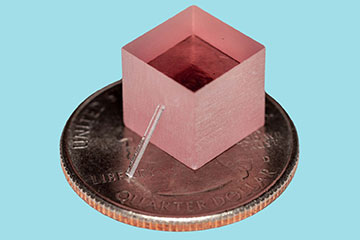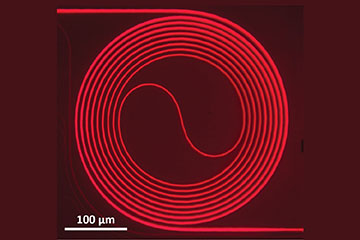
The new Ti:sapphire laser leans against a block of bulk titanium-doped sapphire. For scale, both sit atop a US quarter. [Image: Yang et al., Nature]
For more than four decades, lasers made with titanium-doped sapphire crystals have enabled much research requiring tunable, ultrashort-pulsed sources of red and near-infrared light. However, their large size and the need for high-power pump lasers to provide them with sufficient energy have generally restricted them to tabletop applications, even as the world is moving toward chip-scale devices.
Now, researchers at a US university have devised continuous-wave Ti:sapphire lasers and waveguide amplifiers that fit onto a photonic chip (Nature, doi: 10.1038/s4156-024-07457-2). The laser array measures only 8 mm × 0.5 mm yet exploits the wide gain bandwidth of the solid-state material to operate at a peak output power of 1 kW.
“In our work we managed to guide and localize the optical field directly in the gain material (Ti:sapphire), which increased the overlap between the optical field and gain material and significantly reduced the lasing threshold,” says Optica Fellow Jelena Vučković, who led the laser study at Stanford University.
Ti:sapphire lasers
The key restriction on shrinking Ti:sapphire lasers from their current size and complexity has been the short fluorescence lifetime of the Ti3+ ion within the solid-state laser crystal. Also, these lasers have typically required high pump intensities to produce a decent amount of amplification.
Various groups have tried to shrink the Ti:sapphire laser, including a team at Yale University, USA, that bonded the crystal material onto a nitride chip. “However, optical waves were guided and localized in the nitride layer, which means that only an evanescent tail of the wave overlapped with a Ti:sapphire crystal,” Vučković says. “Since optical field intensity is much smaller in the evanescent tail, that reduces gain and subsequently increases lasing threshold.”

Optical image of the Ti:sapphire waveguide amplifier. This one fits in a 0.5-mm square. [Image: Yang et al., Nature]
By optimizing the pattern-transfer process with a 200-nm-thick chromium mask designed for Ti:sapphire, Vučković and her colleagues bonded the crystal to an insulator, thinned it to several hundred nanometers and etched whispering-gallery-mode resonators into the material. The pump and lasing modes almost completely overlapped―up to 99.5% at a wavelength of 650 nm―thanks to the waveguide geometry.
Shrinking the pump, too
For the initial characterization of the chip-sized Ti:sapphire laser array, the Stanford team used a standard tabletop green laser of the type usually used to pump Ti:sapphire systems. The model’s mass exceeds 10 kg and its cost is roughly US$30,000―metrics hardly encouraging to the photonic chip industry.
However, for the final experiments demonstrating tunability and applications, the team switched to a 10-mm-long laser diode that costs only US$37. The authors wrote, “This complete integrated system driven by a cheap incoherent light source is the decisive first step towards democratizing the Ti:sapphire laser technology for real-world applications.”
Bright possibilities
To demonstrate how the millimeter-scale laser array might perform in a practical application, the team coupled the array’s output into a cavity quantum electrodynamics experiment involving artificial atoms (color centers) in silicon carbide.
Potentially, hundreds or thousands of these tiny Ti:sapphire lasers could be produced in an array on a single chip, and they could be coherently coupled for high output powers, Vučković says. However, her team has not yet demonstrated such coupling.
Vučković’s group is now working on developing mode-locked (pulsed) and tunable Ti:sapphire lasers for use on a chip. They are also integrating crystal gain materials with silicon–nitride chips for greater laser isolation and frequency stabilization―keys to producing useful chip-based laser systems in the near future.
